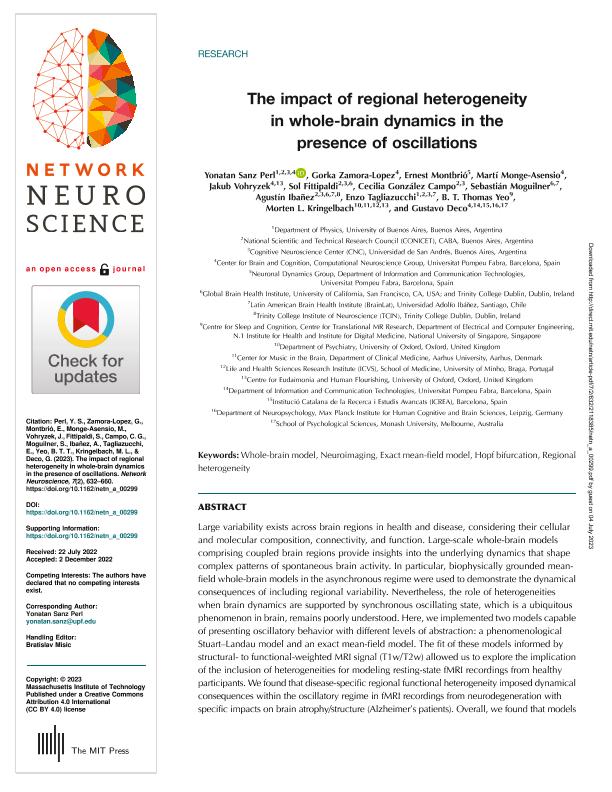Mostrar el registro sencillo del ítem
dc.contributor.author
Sanz Perl Hernandez, Yonatan

dc.contributor.author
Zamora Lopez, Gorka
dc.contributor.author
Montbrió, Ernest
dc.contributor.author
Monge Asensio, Martí
dc.contributor.author
Vohryzek, Jakub
dc.contributor.author
Fittipaldi, María Sol

dc.contributor.author
Gonzalez Campo, Cecilia

dc.contributor.author
Moguilner, Sebastian Gabriel

dc.contributor.author
Ibañez, Agustin Mariano

dc.contributor.author
Tagliazucchi, Enzo Rodolfo

dc.contributor.author
Yeo, B. T. Thomas
dc.contributor.author
Kringelbach, Morten L.
dc.contributor.author
Deco, Gustavo
dc.date.available
2023-07-04T17:57:40Z
dc.date.issued
2022-12
dc.identifier.citation
Sanz Perl Hernandez, Yonatan; Zamora Lopez, Gorka; Montbrió, Ernest; Monge Asensio, Martí; Vohryzek, Jakub; et al.; The impact of regional heterogeneity in whole-brain dynamics in the presence of oscillations; MIT Press Direct; Network Neuroscience; 7; 2; 12-2022; 1-29
dc.identifier.uri
http://hdl.handle.net/11336/202334
dc.description.abstract
Large variability exists across brain regions in health and disease, considering their cellular and molecular composition, connectivity and function. Large-scale whole-brain models comprising coupled brain regions provide insights into the underlying dynamics that shape complex patterns of spontaneous brain activity. In particular, biophysically grounded mean-field whole-brain models in the asynchronous regime were used to demonstrate the dynamical consequences of including regional variability. Nevertheless, the role of heterogeneities when brain dynamics are supporting by synchronous oscillating state, which is a ubiquitous phenomenon in brain, remains poorly understood. Here, we implemented two models capable of presenting oscillatory behaviour with different levels of abstraction: a phenomenological Stuart Landau model and an exact mean-field model. The fit of these models informed by structural-to-functional–weighted MRI signal (T1w/T2w) allowed to explore the implication of the inclusion of heterogeneities for modelling resting-state fMRI recordings from healthy participants. We found that disease-specific regional functional heterogeneity imposed dynamical consequences within the oscillatory regime in fMRI recordings from neurodegeneration with specific impacts in brain atrophy/structure (Alzheimer patients). Overall, we found that models with oscillations perform better when structural and functional regional heterogeneities are considered showing that phenomenological and biophysical models behave similarly at the brink of the Hopf bifurcation.
dc.format
application/pdf
dc.language.iso
eng
dc.publisher
MIT Press Direct
dc.rights
info:eu-repo/semantics/openAccess
dc.rights.uri
https://creativecommons.org/licenses/by/2.5/ar/
dc.subject
WHOLE-BRAIN MODELS
dc.subject
STUART-LANDAU OSCILLATORS
dc.subject
EXACT MEAN-FIELD
dc.subject
REGIONAL HETEROGENEITY
dc.subject
RESTING STATE FMRI
dc.subject.classification
Neurociencias

dc.subject.classification
Medicina Básica

dc.subject.classification
CIENCIAS MÉDICAS Y DE LA SALUD

dc.title
The impact of regional heterogeneity in whole-brain dynamics in the presence of oscillations
dc.type
info:eu-repo/semantics/article
dc.type
info:ar-repo/semantics/artículo
dc.type
info:eu-repo/semantics/publishedVersion
dc.date.updated
2023-06-29T13:16:11Z
dc.identifier.eissn
2472-1751
dc.journal.volume
7
dc.journal.number
2
dc.journal.pagination
1-29
dc.journal.pais
Estados Unidos

dc.description.fil
Fil: Sanz Perl Hernandez, Yonatan. Consejo Nacional de Investigaciones Científicas y Técnicas; Argentina. Universidad de Buenos Aires; Argentina. Universidad de San Andrés; Argentina. Universitat Pompeu Fabra; España
dc.description.fil
Fil: Zamora Lopez, Gorka. Universitat Pompeu Fabra; España
dc.description.fil
Fil: Montbrió, Ernest. Universitat Pompeu Fabra; España
dc.description.fil
Fil: Monge Asensio, Martí. Universitat Pompeu Fabra; España
dc.description.fil
Fil: Vohryzek, Jakub. Universitat Pompeu Fabra; España. University of Oxford; Reino Unido
dc.description.fil
Fil: Fittipaldi, María Sol. Consejo Nacional de Investigaciones Científicas y Técnicas; Argentina. Universidad de San Andrés; Argentina. University of California; Estados Unidos. Trinity College; Irlanda
dc.description.fil
Fil: Gonzalez Campo, Cecilia. Consejo Nacional de Investigaciones Científicas y Técnicas; Argentina. Universidad de San Andrés; Argentina
dc.description.fil
Fil: Moguilner, Sebastian Gabriel. University of California; Estados Unidos. Trinity College; Irlanda. Universidad Adolfo Ibañez; Chile
dc.description.fil
Fil: Ibañez, Agustin Mariano. Consejo Nacional de Investigaciones Científicas y Técnicas; Argentina. Universidad de San Andrés; Argentina. University of California; Estados Unidos. Trinity College; Irlanda. Universidad Adolfo Ibañez; Chile
dc.description.fil
Fil: Tagliazucchi, Enzo Rodolfo. Consejo Nacional de Investigaciones Científicas y Técnicas; Argentina. Universidad de Buenos Aires; Argentina. Universidad de San Andrés; Argentina. Universidad Adolfo Ibañez; Chile
dc.description.fil
Fil: Yeo, B. T. Thomas. National University of Singapore; Singapur
dc.description.fil
Fil: Kringelbach, Morten L.. University of Oxford; Reino Unido. University Aarhus; Dinamarca. Universidade do Minho; Portugal
dc.description.fil
Fil: Deco, Gustavo. Universitat Pompeu Fabra; España. Max Planck Institute for Human Cognitive and Brain Sciences; Alemania. Monash University; Australia
dc.journal.title
Network Neuroscience
dc.relation.alternativeid
info:eu-repo/semantics/altIdentifier/url/https://direct.mit.edu/netn/article/7/2/632/114124/The-impact-of-regional-heterogeneity-in-whole
dc.relation.alternativeid
info:eu-repo/semantics/altIdentifier/doi/https://doi.org/10.1162/netn_a_00299
Archivos asociados
